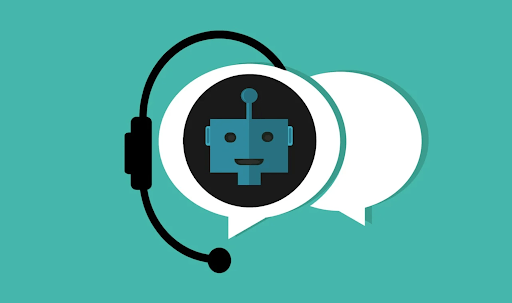Contents:
– What Is A Conversational User Interface (CUI)?
– Define Your Chatbot Goals
– Keep Conversation Quality and Flow in Mind
– Take Care of Your Chatbot Branding 
– Test Again and Again, Both Pre-Launch, and Post-Launch
– Go Forth and Chat
All humans are conversationalists at heart. We’re at our best when we’re interacting, whether it be with family, colleagues, or even machines.
The journey toward conversational interfacing has been a constant one since the dawn of computing, moving from code to written commands to spoken requests.
There’s just something natural about speaking or texting with our devices as we would verbally. According to Business Insider, nearly 40% of internet users worldwide prefer chatbots over less conversational virtual agents.
The universal popularity of voice user interfaces such as Siri, Alexa, and Google Assistant only further evidences the shift toward natural, conversational interactions between user and computer. These systems meet users where they are, programmed to “speak human” rather than expecting users to “speak machine”.
Conversing with our machines is no passing fad either – according to research from Allied Market Research, the global voice user interface industry generated $13.65 billion in 2020 and is set to gain another $95.41 billion by 2030.
Now is the ideal time to bring conversational tools into your business’s user interface design. Read on to discover how to make them work for you – and how to avoid some common chatbot pitfalls.
What Is A Conversational User Interface (CUI)?
A Conversational User Interface, or CUI, is an interface that enables people and computer systems to interact using voice or text, taking cues from real-life conversations. Language analyzing software helps bots recognize and interpret human speech, based on a vast library of conversational patterns.
CUI can improve interactions on the web, via mobile apps, or even over the phone. Its primary benefit is the ease of use, allowing users to ask for exactly what they want without having to learn particular keywords or phrasing.
The effect is one of a one-to-one conversation. The difference is that a bot can conduct thousands of conversations at once. What’s more, the language processing technology behind chatbots and voice interfaces is capable of learning as it goes along, evolving with its users.
It’s no wonder companies are designing chatbots and voice user interfaces to suit a growing list of business needs, from lead generation to customer support.

Define Your Chatbot Goals
It’s tempting to dive straight into bot design, but before doing so you need to define an evidence-driven purpose for the interface to fulfill.
As with all customer experience solutions, your conversational user interface needs to be customer-centric. Build a concrete vision of who will be interacting with your AI system, using data analytics to understand each audience persona. Now imagine the experience of your site, service, or product through their eyes.
Identify any pain points in the user where conversational support could help. For example, if customers tend to leave your site at a certain point in the sales funnel, placing a live chat window here could re-engage them. Alternatively, if your site gets a lot of searches for customer contact information, a readily visible help bot on the homepage could save a lot of frustration.
It also pays to consider your own pain points, and whether a bot might assist in the smooth running of business operations. If your company receives a lot of customer calls regarding a particular service or policy, a helpful voice bot could run them through the options best suited to their question. This would leave human agents free to answer more challenging queries, increasing employee productivity and customer satisfaction at the same time.
Keep Conversation Quality and Flow in Mind
Once you know what your AI agent will achieve, it’s time to design the conversation. A number of user interface service providers now offer a “choose your adventure”-style bot service. These allow designers to create a conversation from the ground up, plugging in questions and a range of clickable suggestions responses, such as words, phrases, or even emojis.
This solution is ideal for certain applications, such as a tutorial to a specific service, or an interactive contents page for a self-service help portal. However, if you truly want to wow your customers, you need to leave them the freedom to request and react in whatever way seems most natural to them. This calls for a more complex AI, using Natural Language Processing (NLP) to understand and analyze on the go.
When creating a script for an NLP chatbot, it’s crucial to keep conversation quality and flow in mind. To be truly engaging, the chat needs to feel natural and unstilted from start to finish. Run quality assurance checks at each stage of the design process, doubling back on yourself and checking that what you’ve input feels like natural speech.
As you reach the final stages of your QA processes, you can even invite end users to try out the prototype as a beta model. This has the double advantage of promoting your new service and gaining a wider sense of what does and doesn’t feel natural to users. Get feedback from your beta testers on how genuine the conversation felt, and how they gauge the bot’s tone of voice.

Take Care of Your Chatbot Branding
When it comes to tone, don’t forget that your voice or chatbot is a front-line ambassador for your brand. This makes it not only a tool but a crucial branding opportunity. By imbuing the chat journey with your brand’s persona, you can create a sense of genuine connection and build customer trust.
Don’t worry about making your bots sound human – after all, it’s important not to mislead customers into thinking they’re speaking to an agent. However, according to the Journal of Retailing and Consumer Services, people prefer virtual assistants who seem genuinely happy. That means you can swap out some of the brusque and businesslike responses in your bot’s script for something a little more memorable.
Consider the voice you want your brand to have – is it the helpful everyman, the knowledgeable sage, or a mold-breaking rebel? Now, how does that voice actually sound? Let your conversational user interface express this, be it through a unique text-to-speech voice or an identifiable writing style.
Be careful not to sacrifice clarity for personality, however. According to research from Penn State University, bots with human-like features but low interactivity can cause more frustration than those with no personality. Therefore, it pays to prioritize quick and correct responses over a fun user experience.
After all, prompt and informative communication should be just as much a part of your brand identity as your tone of voice.
Test, Again and Again, Both Pre-Launch, and Post-Launch
With a range of bot design software services available, even those without programming know-how can quickly get a conversational user interface up and running. It’s important not to be too hasty though, as poor customer interactions in the first few weeks can lead to a less than desirable reputation with your customer base.
Instead, make a prototype an essential part of your pre-launch checklist. This will allow you and your colleagues to interact with the system before it goes live, putting it to the test with different queries and conversational approaches. Keep a detailed log of potential issues, and use these exploratory tests to adjust each conversational branch to perfection.
Bear in mind that you already know the desired outcome of the conversation, so bring in some testers who haven’t seen the bot in production. They will be far more likely to confound your script with edge cases or colloquial phrasing.
At each phase of testing, ask yourself whether the chatbot understands users’ questions, whether its responses are prompt, accurate, and relevant, and whether the conversation is engaging and enjoyable. Consider whether there are too many or too few conversation stages before an endpoint is reached.
Over time, this active testing will help to build an interaction model, including the nuances of different user requests, and the appropriate AI responses in each case. For example, in some cases, users won’t think to use any of the specific keywords that a bot is programmed to link with a particular answer. In these cases, the bot could continue the conversation by eliciting more information until an appropriate keyword is used.

Go Forth and Chat
As we become increasingly comfortable with verbally asking our phones for directions or typing full questions into Google, it’s clear that conversational interfacing is the new norm.
In fact, the chatbot market is predicted to grow at a rate of 24.9% between now and 2028. Moreover, businesses now employ specialists in conversational marketing – an area of marketing-driven entirely by chat and voice interfaces.
The growth of chatbot and voice interface design services means that even smaller enterprises can quickly harness the power of AI. Correctly used, CUI can become a powerful tool in any business’s arsenal, acting as a support agent, a sales assistant, promoter, lead generator, and even a recruiter.
However, it’s important to remember that the user interface is only as good as the script it’s given. Take time to create a conversation that’s engaging, informative, and true to your brand. With thorough testing in production and a crew of end-user beta testers, you can look forward to welcoming a bot to your team.

Kate Priestman – Head Of Marketing, Global App Testing
Kate Priestman is the Head of Marketing at Global App Testing, a trusted and leading end-to-end software application testing solution for QA challenges. Kate has over 8 years of experience in the field of marketing, helping brands achieve exceptional growth. She has extensive knowledge of brand development, lead and demand generation, and marketing strategy — driving business impact at its best. You can connect with her on LinkedIn.
The post What Is A Conversational User Interface (CUI) & How to Leverage It appeared first on Inbenta.
- "
- 2020
- About
- According
- accurate
- active
- ADvantage
- agents
- AI
- Alexa
- All
- Allowing
- already
- analytics
- Another
- app
- Application
- applications
- apps
- AREA
- Arsenal
- Assistant
- audience
- available
- become
- BEST
- beta
- Billion
- Bot
- bots
- branding
- brands
- build
- business
- businesses
- care
- cases
- Cause
- challenges
- checking
- Checks
- code
- Common
- Communication
- Companies
- company
- complex
- computing
- connection
- consumer
- contents
- continue
- Conversation
- conversations
- could
- Creating
- crucial
- Customer satisfaction
- Customer Support
- Customers
- data
- Data Analytics
- Demand
- Design
- designing
- Development
- Devices
- different
- Doesn’t
- double
- doubling
- Edge
- effect
- Endpoint
- essential
- evolving
- example
- experience
- family
- Features
- feedback
- First
- flow
- Forward
- Free
- Freedom
- Fulfill
- full
- fun
- Global
- good
- Growing
- Growth
- happy
- having
- head
- height
- help
- helpful
- helps
- here
- homepage
- How
- How To
- HTTPS
- Humans
- Identity
- Impact
- important
- improve
- Including
- industry
- information
- Insider
- interaction
- interactive
- Interface
- Internet
- issues
- IT
- knowledge
- language
- lead
- leading
- LEARN
- learning
- Leverage
- Library
- LINK
- List
- little
- Machines
- Making
- Market
- market research
- Marketing
- mind
- Mobile
- model
- most
- moving
- Natural
- offer
- Operations
- Opportunity
- Options
- Pain
- People
- Personality
- phase
- phones
- phrases
- policy
- poor
- Portal
- power
- powerful
- primary
- process
- Product
- Production
- productivity
- Programming
- purpose
- quality
- question
- quickly
- range
- React
- research
- Run
- running
- sales
- satisfaction
- sense
- service
- Services
- set
- shift
- site
- So
- Software
- something
- Stage
- start
- State
- Strategy
- style
- support
- system
- Systems
- team
- Technology
- test
- Testing
- Thinking
- thousands
- Through
- time
- tools
- understand
- unique
- Universal
- use
- users
- Virtual
- visible
- vision
- Voice
- W
- web
- What
- What is
- whether
- WHO
- without
- words
- Work
- worldwide
- writing
- years













